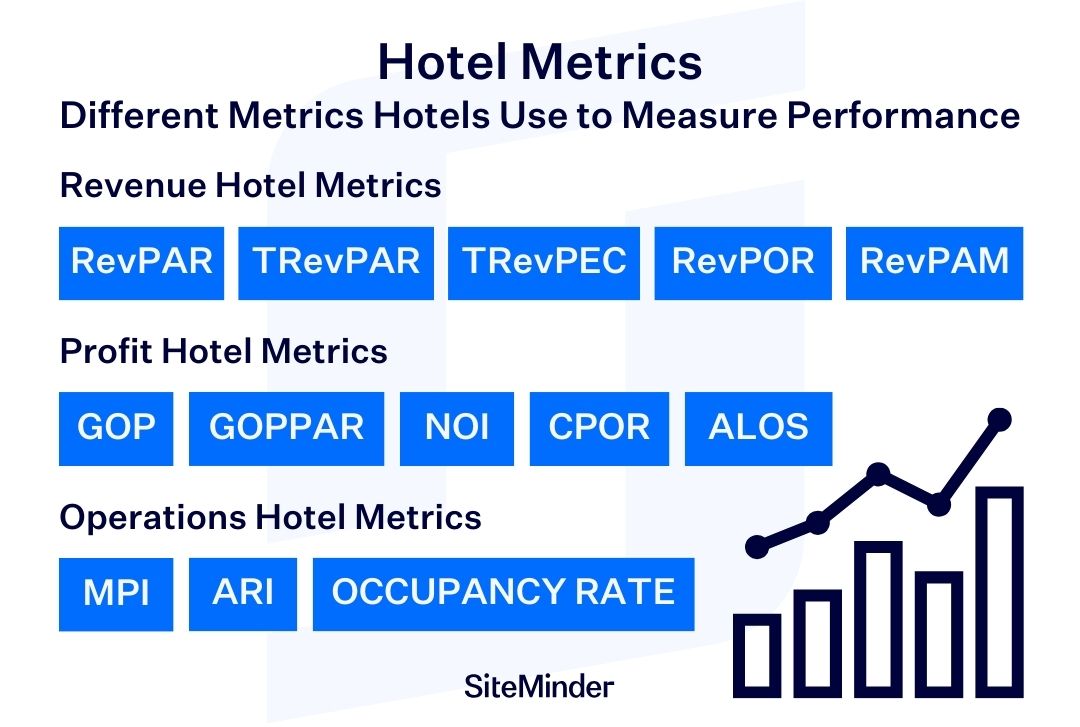What are hotel metrics?
Hotel metrics, often referred to as key performance indicators (KPIs), are essential data points that hoteliers use to measure the performance and success of their establishment.
These metrics encompass a wide range of areas, from financial figures like revenue per available room (RevPAR) and average daily rate (ADR) to operational aspects such as occupancy rates and guest satisfaction scores.
By closely monitoring these metrics, hotel managers can gain valuable insights into their hotel’s strengths and areas for improvement.
For instance, a consistently high occupancy rate might indicate effective marketing strategies, while low guest satisfaction scores could point to potential issues in service quality or amenities.
In today’s competitive hospitality industry, understanding and optimising these metrics is crucial. They not only provide a snapshot of the hotel’s current performance but also guide strategic decision-making, ensuring that the establishment remains profitable and continues to meet the ever-evolving needs of its guests.
Table of contents
What should be included in hotel metrics?
Hotel operations are incredibly varied, with many moving parts that interact with and support one another. As you can imagine, this translates into a significant number of interrelated metrics; all of which must be monitored to ensure a complete view of performance.
This said, not every hotel will place the same level of importance on every metric, or the same metrics, at the same time. Revenue and profit are always important, but more specific KPIs around average length of stays may not always be as integral to highlight in hotel metrics reports.
Regardless of emphasis, together these metrics form the backbone of a hotel’s analytical approach, ensuring profitability and enhanced guest experiences.
Hotel industry standard metrics
Here are a few of the most common hotel metrics that hoteliers track:
- Occupancy rate is crucial, indicating the percentage of occupied rooms over a specific period. It offers insights into room demand and helps in forecasting.
- Average daily rate (ADR) measures the average revenue earned from each occupied room per day, shedding light on pricing strategies.
- Revenue per available room (RevPAR) combines the occupancy rate and ADR to give a comprehensive view of both room sales and revenue.
- Guest satisfaction metrics, such as Net Promoter Score (NPS) and online reviews, gauge guest experiences and areas of improvement.
- Cost per acquisition (CPA) helps in understanding the cost involved in acquiring a customer, essential for budgeting and marketing strategies.
- Distribution channel performance is vital to know which channels (like OTAs, direct bookings) are most profitable.
Boost your important metrics with SiteMinder
Empower your hotel with industry-leading features and insights. With SiteMinder, you're always a step ahead.
Learn more
Types of hotel metrics
Generally, hotel metrics will fall into one of three main categories: revenue, profit, and operations, each with its own unique insights into performance.
1. Revenue hotel metrics
Revenue is what keeps your hotel open so having a goal aligned with your income is obviously important.
How you measure your success is dependent on what targets you set. For example, you might set out to achieve a revenue lift of 10% year-on-year. Or you might have the goal of boosting RevPAR by 5%.
Here are some revenue hotel metrics to consider:
- RevPAR – Revenue per available room gives you an idea of your ability to fill your rooms at an average rate. It can be calculated by multiplying your average daily rate by your occupancy rate.
- TrevPAR – Total revenue per available room takes into account all the revenue from your property, not just your room sales. It can be calculated by dividing your total revenue by your available rooms in a set period.
- TrevPEC – Total revenue per client can be used to look at individual guest expenditure and how this applies to your hotel’s overall revenue performance. Simply divide your total revenue with the number of guests staying at your property for any given period.
- NRevPAR – Net revenue per available room takes into account the expenses incurred by you in order to fill your rooms and can be calculated by dividing your room revenue, minus costs, by available rooms.
- RevPOR – Revenue per occupied room only considers filled rooms so gives you a better understanding of the profit you make from guests who are actually staying with you. It can help you track revenue from other departments such as food and beverage. Calculate it by dividing your total revenue by occupied rooms.
- ReRTI – RevPAR Room Type Index is quite a newly developed metric that helps hoteliers see which room types are the most profitable, and how promotions might affect overall performance.
- RevPAM – Revenue per available metre is a metric that takes the entire space of the property into the equation; total revenue / divided by the total available square metre(s) of the space (m2). It lets you get ever more granular with how you drive revenue.
2. Profit hotel metrics
You certainly don’t want to run a business that puts you into bankruptcy so driving and measuring profit is incredibly important for the longevity of your hotel.
You might set a goaI that addresses monthly profit, knowing if you hit your target each month your annual figure will take care of itself.
Here are some profit hotel metrics to know:
- GOP – Gross operating profit is simply a calculation of your profits after acquisition costs have been deducted.
- GOPPAR – Gross operating profit per available room measures the distinction between your profit and available rooms. GOPPAR equals GOP / total available rooms
- NOI – Slightly different to GOP, Net operating income calculates your income after operating expenses have been deducted but before interest and taxes have been applied.
- CPOR – Cost per occupied room lets you identify the average cost per occupied room to give you an idea of how healthy your cost of acquisition is. How much are you spending to secure a booking?
- ALOS – Average length of stay tells you how long your guests stay with you on average. The higher the better since, the less turnover there is the less labour costs you incur. Divide your total occupied rooms nights by the number of bookings to get your ALOS.
3. Operations hotel metrics
- Occupancy rate – As business as usual as metrics get, your occupancy rate is determined by dividing your occupied rooms by your total available rooms. A healthy occupancy rate is certainly an indicator of success but is much too general to rely on.
- MPI – Market penetration index is a way to directly compare yourself with your competitors. This is calculated by: your occupancy rate / market occupancy rate x 100. Essentially a score below 100 means you are being outdone by your competitors and a score above 100 means you’re performing better.
- ARI – Average rate index is similar to MPI, but for your rates instead of your occupancy. Divide your ADR by the competitive market’s ADR to get your ARI. A result higher than 1 shows that you are priced above your competitors.

Improving hotel KPIs
Hotel KPIs help you evaluate whether your strategy is working and also give your whole team something to focus on and drive towards on a day-to-day basis.
Quick tips to develop KPIs for the hotel industry:
- Limit the amount of KPIs you have; keep it to big priorities
- Clearly define how you will measure each KPI
- Set a specific target for your KPI
- Ensure you have accurate data sources and tools
- Run reports that detail data analysis and operational activities
- Looking at online review scores
- Analysing customer feedback forms/surveys
- Tracking social media follower numbers
- Reporting on social media engagement
- Measuring uptake of loyalty or rewards programs
- Measuring share of voice
Other KPIs your hotel can utilise
Sometimes the things that happen in the background are the most crucial. We’re talking about operational KPIs that have nothing to do with occupancy or room rates, but can have significant impacts on your bottom line.
When developing KPIs for your hotel make sure you include:
- Energy management – Electricity is a huge expense, particularly for larger hotels. Anything you can do to lower this cost will be an automatic win for your bank account. You should also consider the rising trend of guests wanting to book with environmentally responsible and sustainable brands. Think about long term investments in smart technology and sensors that will help you save on energy when lighting or other services aren’t being used.
- Labour – Naturally you have staff and you have to pay them. Increasing efficiency at your hotel will allow you to lower labour costs without having to let any staff go. Using software to manage your hotel doesn’t replace staff, but rather it allows them to do their job more effectively. For example, using hotel tech to manage housekeeping schedules can save hours of time every week, allowing you to check guests in and out faster and more often.
- Water – Just like power, water can be a hefty expense for a hotel which runs 24/7. You can’t necessarily control this as much as electricity but tightening the screws as much as you can goes a long way over the course of a year.
- Health and safety – Guests and staff alike want to enjoy a clean, safe, environment at your hotel. Any indication that this is slipping should be addressed because word of mouth spreads quickly and your reputation can free-fall if people think your property’s safety or cleanliness is compromised.
